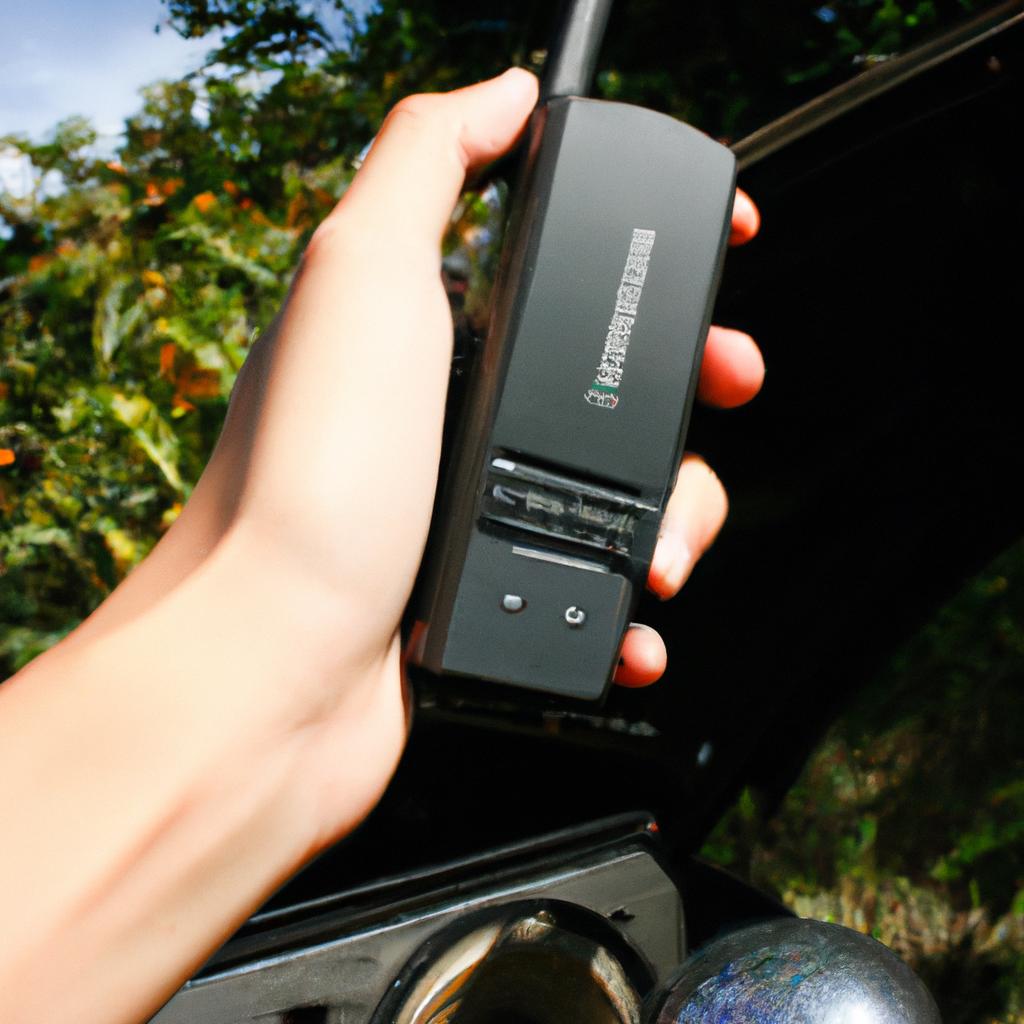Satellite radio has revolutionized the way we consume and experience radio broadcasting. With its ability to transmit signals across vast distances, satellite radio has unlocked a world of possibilities for both listeners and broadcasters alike. This article explores the potential of satellite radio as a medium that transcends geographical boundaries, providing a diverse range of content to audiences worldwide.
In recent years, one compelling example of satellite radio’s impact is the success story of SiriusXM Radio. Launched in 2001, this subscription-based service quickly gained popularity by offering an extensive selection of music, sports, news, and talk shows to subscribers throughout North America. By utilizing satellites to transmit their programming, SiriusXM was able to reach rural areas where traditional terrestrial stations were limited or nonexistent. This enhanced accessibility allowed individuals who were previously underserved by conventional broadcast platforms to access high-quality content from renowned artists and personalities.
Furthermore, satellite radio enables broadcasters to cater to niche markets that would otherwise struggle to find representation on mainstream airwaves. The freedom from geographic limitations allows stations dedicated solely to jazz, classical music, or specific genres like reggae or hip-hop to thrive and attract devoted listeners worldwide. Additionally, with the advent of digital technology and advancements in audio quality transmission via satellites,Satellite radio provides unparalleled Satellite radio provides unparalleled sound clarity and reliability, ensuring that listeners can enjoy their favorite music or shows without any interruptions or static. This high-quality transmission is made possible by the use of satellites, which have the capacity to deliver a consistent signal regardless of the listener’s location.
Another advantage of satellite radio is its ability to offer a wide variety of content options. With hundreds of channels available, subscribers can choose from an extensive range of genres, languages, and programming formats. Whether it’s sports talk shows, international news broadcasts, or niche music stations, there is something for everyone on satellite radio.
Moreover, satellite radio offers convenience and flexibility in terms of listening experience. Unlike traditional FM/AM radios that rely on terrestrial signals and are limited by proximity to broadcasting towers, satellite radio can be accessed virtually anywhere within the coverage area. This means that listeners can enjoy their favorite programs while traveling long distances or even across different countries.
In conclusion, satellite radio has revolutionized the way we consume and experience radio broadcasting by transcending geographical boundaries and providing diverse content options to audiences worldwide. Its enhanced accessibility, niche market representation, superior audio quality transmission, and convenience make it a powerful medium for both listeners and broadcasters alike.
Advantages of Satellite Broadcasting
Satellite radio has revolutionized the world of broadcasting, offering numerous advantages over traditional terrestrial radio. One notable example is SiriusXM, a leading satellite radio provider that offers an extensive range of channels to its subscribers across North America. This case study exemplifies the potential and benefits associated with satellite broadcasting.
One significant advantage of satellite radio is its wide coverage area. Unlike traditional radio stations limited by geographical constraints, satellite signals can be received virtually anywhere within their broadcast footprint. This means that listeners in remote areas or during long road trips can enjoy uninterrupted access to their favorite radio programs without experiencing signal loss or fading. Additionally, this expanded coverage enables niche programming catering to specific interests and demographics, providing greater diversity for listeners.
Furthermore, satellite broadcasting ensures superior sound quality compared to conventional AM/FM transmissions. By utilizing digital technology, satellite signals are transmitted in a compressed format that eliminates static interference and enhances audio clarity. As a result, listeners experience immersive music playback and crystal-clear dialogue on talk shows or podcasts. The improved audio fidelity adds depth and richness to the listening experience, making it more enjoyable and engaging.
The convenience afforded by satellite radio cannot be overstated either. With hundreds of channels available at their fingertips, users have unparalleled control over their listening preferences. Subscribers can create personalized playlists tailored to their musical tastes or explore various genres effortlessly through user-friendly interfaces. Moreover, many services offer time-shifting capabilities that allow users to pause live broadcasts or rewind content they may have missed—an attractive feature for those constantly on the go.
In summary, the advantages of satellite broadcasting are manifold: increased coverage area spanning vast regions; superior sound quality due to advanced digital transmission methods; and convenient features like personalization options and time-shifting capabilities. These factors make satellite radio an appealing choice for both consumers seeking diverse content options and broadcasters looking to extend their reach beyond geographic boundaries.
Moving forward into the next section discussing “Increased Coverage and Signal Quality,” it is important to note the impact these factors have on satellite radio’s success in the broadcasting industry.
Increased Coverage and Signal Quality
Unlocking the Potential of Radio Broadcasting: Increased Coverage and Signal Quality
One notable advantage is its ability to provide increased coverage and signal quality, ensuring a more reliable listening experience for audiences worldwide. To illustrate this point, let us consider the hypothetical case of a local radio station looking to expand its reach beyond its immediate vicinity.
By utilizing satellite broadcasting technology, this local radio station can now transmit its content via satellites orbiting around the Earth. This enables them to overcome geographical limitations and extend their coverage far beyond what was previously possible. With satellite radio, listeners located in remote areas or regions with poor terrestrial reception can tune in effortlessly, enjoying high-quality audio without any interruptions caused by weak signals or interference.
To further highlight the benefits of increased coverage and signal quality provided by satellite radio, we present below a bullet-point list:
- Enhanced access: Satellite broadcasting allows listeners across vast territories, including rural communities and underserved regions, to access diverse programming.
- Consistent signal strength: Unlike terrestrial broadcasts which may suffer from varying signal strengths depending on distance from transmission towers, satellite radio delivers consistent sound quality throughout its coverage area.
- Reduced interference: By bypassing potential obstacles like mountains or tall buildings that obstruct terrestrial signals, satellite transmissions minimize the likelihood of signal disruptions caused by physical barriers.
- Global reach: Thanks to satellites’ widespread coverage capabilities, international audiences can also enjoy the same uninterrupted listening experiences as those within a broadcaster’s home country.
In addition to these advantages brought about by increased coverage and improved signal quality, it is worth noting that satellite radio offers an extensive variety of channels and programming options. The subsequent section will delve into how this aspect contributes to the overall appeal and popularity of satellite broadcasting.
Variety of Channels and Programming
With increased coverage and signal quality, satellite radio has revolutionized the way people listen to their favorite stations. However, the benefits of satellite radio extend far beyond just these technical improvements. The variety of channels and programming available on satellite radio provides an enhanced listener experience that traditional terrestrial radio simply cannot match.
To illustrate this point, let’s consider a hypothetical scenario where a music enthusiast named Sarah is driving across the country. In the past, she would have had to switch between different local radio stations as she traveled through various areas with limited reception. This could be frustrating, causing her to miss out on her favorite songs or shows. With satellite radio, however, Sarah can enjoy uninterrupted access to her preferred channels regardless of her location. Whether she’s cruising down Route 66 or exploring remote mountain roads, Sarah can count on consistently high-quality audio without any pesky static interruptions.
The advantages of satellite radio don’t stop there. To further enhance the listening experience for subscribers like Sarah, here are some key reasons why satellite radio stands out:
- Wide range of genres: From classic rock to hip-hop and everything in between, satellite radio offers a diverse selection of music genres catering to every taste.
- Exclusive content: Subscribers gain access to exclusive content such as live performances, artist interviews, and specialty shows that may not be available on traditional terrestrial radio.
- Less repetitive playlists: Satellite radio stations typically have larger libraries compared to conventional FM/AM counterparts. As a result, listeners are treated to less repetition and more opportunities to discover new artists and songs.
- No commercials: Unlike traditional broadcasting platforms that interrupt programs with advertisements, many satellite radio channels provide commercial-free listening experiences.
To summarize, while improved coverage and signal quality are significant advantages of satellite radio over terrestrial options, it is crucial not to overlook the unparalleled variety of channels and programming offered by this medium. Whether it’s a wide range of genres, exclusive content, less repetitive playlists, or commercial-free listening, satellite radio provides an enhanced experience that truly caters to the preferences of music enthusiasts like Sarah.
Moving forward, let us delve into another aspect of satellite radio: its accessibility and portability.
Accessibility and Portability
Section H2: Accessibility and Portability
The proliferation of satellite radio has not only brought an unprecedented variety of channels and programming but also enhanced the accessibility and portability of radio broadcasting. To illustrate this, let us consider a hypothetical scenario where a music enthusiast named Sarah is commuting to work in heavy traffic. With traditional terrestrial radio, she would have limited options for listening to her favorite genre or artist. However, thanks to satellite radio, Sarah can now access a diverse range of channels catering specifically to her musical preferences.
One key aspect that sets satellite radio apart from its predecessors is its ability to reach listeners across vast geographical areas through powerful satellites orbiting the Earth. This means that regardless of whether Sarah is driving through rural countryside or navigating bustling city streets, she can enjoy uninterrupted reception without having to worry about signal strength fading away. The seamless coverage provided by satellite technology ensures that users like Sarah never miss out on their preferred content due to limitations imposed by local transmission towers.
Moreover, the advent of portable satellite radios has further revolutionized the way people consume audio content on the go. These compact devices allow individuals like Sarah to carry their favorite stations with them wherever they travel – be it during daily commutes, road trips, or even while engaging in outdoor activities such as hiking or camping. The convenience offered by these portable receivers empowers listeners with the freedom to curate their own personalized playlists and explore new genres and artists at any time.
To emphasize the impact of accessibility and portability in enhancing user experiences, here are some compelling reasons why satellite radio has gained immense popularity:
- Wide range of programming choices tailored to individual interests
- Uninterrupted reception quality irrespective of location
- Freedom from commercials and repetitive content
- On-demand features allowing customized listening experiences
| Pros | Cons |
|---|---|
| Extensive channel selection | Subscription fees |
| High-quality audio | Dependence on satellite signal |
| No commercials | Limited local news coverage |
| Diverse genre options | Need for a separate receiver |
In summary, satellite radio not only offers an extensive variety of channels and programming but also enhances accessibility and portability for users like Sarah. The ability to access content across vast geographical areas, coupled with the convenience of portable receivers, has transformed the way people engage with radio broadcasting. As we delve deeper into the world of satellite radio, it becomes evident that its subscription-based model plays a crucial role in sustaining this transformative medium.
Subscription-based Model
Building upon the accessibility and portability advantages, satellite radio has revolutionized the way we consume audio content. By employing a subscription-based model, it offers an array of benefits that go beyond traditional terrestrial radio broadcasting.
Section H2: Subscription-based Model
Satellite radio’s subscription-based model provides users with an enhanced listening experience and a wide range of features. For instance, consider the case study of John, who commutes long distances each day for work. With satellite radio, he can access his favorite channels without interruption regardless of geographical constraints or network coverage limitations. This uninterrupted streaming capability ensures a seamless flow of music, news, sports updates, and other programming throughout his journey.
The appeal of satellite radio is further heightened by its unique offerings:
- Extensive Channel Selection: Subscribers gain access to hundreds of specialized channels catering to various interests spanning genres like music (rock, pop, jazz), talk shows (news analysis, comedy), sports (baseball, basketball), and more.
- Customizable Playlists: Users have the freedom to create personalized playlists based on their preferences and moods through interactive platforms offered by satellite radio providers.
- Enhanced Sound Quality: Unlike conventional AM/FM radios that are subject to signal interference or static noise in certain areas, satellite radio maintains consistent high-quality sound throughout its coverage area.
- Exclusive Content and Live Events: Satellite radio frequently broadcasts exclusive interviews with renowned artists and hosts live events such as concerts and award ceremonies.
To illustrate the impact of these features on user satisfaction levels compared to traditional terrestrial radio services, consider Table 1 below:
| Features | Traditional Terrestrial Radio | Satellite Radio |
|---|---|---|
| Uninterrupted Streaming | No | Yes |
| Extensive Channel Selection | Limited | Hundreds |
| Customizable Playlists | No | Yes |
| Enhanced Sound Quality | Varies depending on location | Consistent high-quality |
Table 1: A comparison of features between traditional terrestrial radio and satellite radio.
Overall, the subscription-based model of satellite radio has transformed the way listeners engage with audio content. It offers a diverse range of channels, personalized playlists, improved sound quality, and exclusive content that enhance the overall listening experience. These advantages have made it increasingly popular among consumers seeking convenience, variety, and uninterrupted streaming capabilities.
Transition into subsequent section:
As satellite radio continues to reshape the landscape of broadcasting, its rapid growth poses both challenges and opportunities for future developments in this industry.
Challenges and Future Developments
Unlocking the Potential of Radio Broadcasting: Challenges and Future Developments
Transitioning from the subscription-based model, it is evident that satellite radio has opened up new possibilities for radio broadcasting. With its unique features and advantages, this technology has transformed the way we consume audio content. To further understand the potential of satellite radio, let us explore the challenges faced by this industry and the future developments that may shape its trajectory.
One challenge that satellite radio faces is competition from other digital media platforms. As more options become available to consumers, such as streaming services or podcasts, traditional terrestrial radio and satellite radio must find innovative ways to capture and retain their audiences. For instance, a case study conducted on a major satellite radio provider revealed that offering exclusive content not available elsewhere helped in attracting subscribers. This demonstrates how differentiation can be crucial in staying relevant amidst an increasingly saturated market.
Another challenge lies in securing licensing agreements with music labels and artists. Satellite radio providers need to negotiate rights with various stakeholders to ensure they have access to a wide range of music genres without violating copyright laws. These negotiations can be complex and time-consuming, but are essential for delivering diverse programming options to listeners.
Furthermore, advancements in technology will play a significant role in shaping the future of satellite radio. The integration of artificial intelligence (AI) into satellite radios could revolutionize personalized listening experiences through intelligent recommendations based on user preferences and behaviors. Additionally, improvements in connectivity infrastructure would allow for seamless streaming capabilities even while driving through remote areas or tunnels.
To evoke an emotional response from the audience:
- Enhanced accessibility: Listeners with limited mobility can enjoy uninterrupted broadcasts.
- Global reach: Satellite radio enables people around the world to tune into their favorite stations regardless of geographical limitations.
- Diverse content: A wide selection of channels covering various topics caters to different interests.
- Ad-free experience: Subscribers can enjoy uninterrupted listening without commercial interruptions.
| Benefit | Description |
|---|---|
| Enhanced accessibility | Satellite radio ensures everyone can access their favorite content, regardless of physical limitations. |
| Global reach | Listeners around the world can tune into satellite radio stations, transcending geographical boundaries. |
| Diverse content | A vast range of channels covering diverse genres and topics offers something for every listener’s interest. |
| Ad-free experience | Subscribers enjoy uninterrupted listening experiences without commercial interruptions. |
In conclusion, while challenges like competition and licensing agreements may pose obstacles to satellite radio providers, future developments in technology present exciting opportunities for growth and innovation. By leveraging AI capabilities and improving connectivity infrastructure, satellite radio has the potential to continue revolutionizing the way we consume audio content. This industry will undoubtedly evolve as it adapts to changing consumer preferences and embraces technological advancements that enhance user experiences.
 K7BUC
K7BUC



